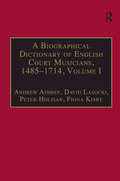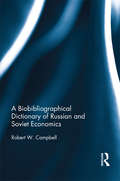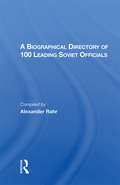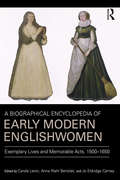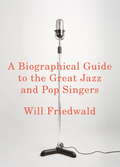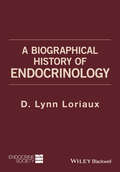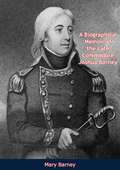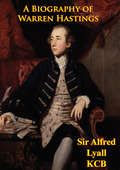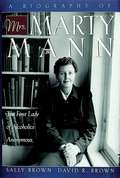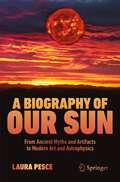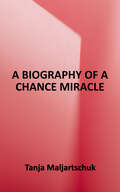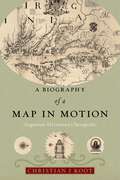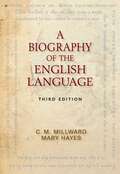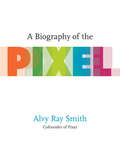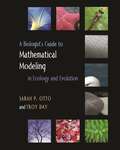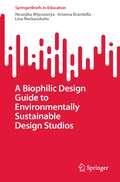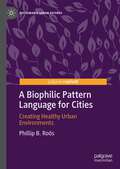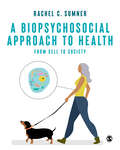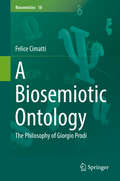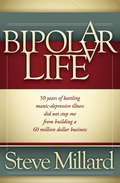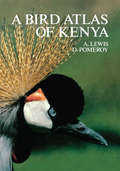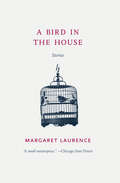- Table View
- List View
A Biographical Dictionary of English Court Musicians, 1485-1714, Volumes I and II
by David LasockiCompiled by scholars with unrivalled knowledge of the sources, this dictionary provides biographies of all musicians and instrument makers employed by the English court from 1485-1714. A number of the musicians featured here have never previously received a dictionary entry. Coverage of these minor figures helps to flesh out the picture of musical life in the court in a way which individual studies of more major composers cannot. In addition to basic biographical details, entries feature information on: appointments; probate material; family background; heraldry; signatures and holograph documents; subscriptions to books; bibliographic references. A finding-list of variant names, details of the succession of court places assumed by musicians and an index of subjects and place names completes this comprehensive reference work.
A Biographical Dictionary of Russian and Soviet Economists
by Robert CampbellDespite the restrictions on their work and actions, the economists of the Soviet period produced a great deal of bold and important work. With the erosion of the old Stalinist controls, economists in the Soviet Union themselves became very interested in the history of their profession, not least in order to find authentic voices that might offer reinforcement or counterpoint to the policy analyses and recommendations with which policy makers in the transition countries are today being bombarded. This major new reference work pulls together many years of research in order to present a bio-bibliographic dictionary of Russian and Soviet economists, many of whom have previously had no coherent record compiled of their careers, achievements and wider significance. Through exploring this rich tradition of economic thought, we can go some way in understanding the role of economists in the functioning of the Soviet system, as well as bringing previously forgotten work to light, raising new questions, and providing a memorial to those who suffered as a result of the system. This hugely detailed and important new volume takes into account all the nuances of the story of Russian and Soviet economic thought, such as regional issues, the reform and transition to a market economy, and the economic output of non-economists. Featuring nearly 500 entries, and including a detailed contextual introduction, this landmark volume will be a vitally important reference work for all those with an interest in the history of economic thought, the history of economics and Russian and Soviet history more generally.
A Biographical Directory Of 100 Leading Soviet Officials
by Alexander RahrThis updated and expanded biographical directory is the first in the series of directories published by Radio Liberty since 1981 to include photographs. The volume provides detailed information about the careers and lives of current members of top Soviet party and government bodies, officials of the armed forces, and diplomats. Also represented are a number of middle-ranking officials who stand a good chance of attaining top-level posts in the next few years. Entries are in alphabetical order, and each entry includes a biographical sketch, a career chronology, a summary of the content of published articles and speeches, and details of political alignment and connections. The volume is current through summer 1990 and documents the substantial recent turnover in party organizations such as the Central Committee and in state bodies such as the newly elected Council of People's Deputies. It is an indispensable reference for scholars, business people, journalists, government officials, and others trying to follow the rapid changes taking place in the USSR.
A Biographical Encyclopedia of Early Modern Englishwomen: Exemplary Lives and Memorable Acts, 1500-1650
by Carole Levin Jo Eldridge Carney Anna Riehl BertoletFrom the exemplary to the notorious to the obscure, this comprehensive and innovative encyclopedia showcases the worthy women of early modern England. Poets, princesses, or pirates, the women of power and agency found in these pages are indeed worth knowing, and this volume will introduce many female figures to even the most established scholars in early modern studies. Rather than using the conventional alphabetical format of the standard biographical encyclopedia, this volume is divided into categories of women. Since many women will fit in more than one category, each woman is placed in the category that best exemplifies her life, and is cross referenced in other appropriate sections. This structure makes the book an interesting read for seasoned scholars of early modern women, while students need not already be familiar with these subjects in order to benefit from the text. Another unusual feature of this reference work is that each entry begins with some incident from the woman’s life that is particularly exciting or significant. Some entries are very brief while others are extensive. Each includes a source listing. The book is well illustrated and liberally sprinkled with quotations of the time either by or about the women in the text.
A Biographical Guide to the Great Jazz and Pop Singers
by Will FriedwaldWill Friedwald's illuminating, opinionated essays--provocative, funny, and personal--on the lives and careers of more than three hundred singers anatomize the work of the most important jazz and popular performers of the twentieth century. From giants like Ella Fitzgerald, Louis Armstrong, Frank Sinatra, and Judy Garland to lesser-known artists like Jeri Southern and Joe Mooney, they have created a body of work that continues to please and inspire. Here is the most extensive biographical and critical survey of these singers ever written, as well as an essential guide to the Great American Songbook and those who shaped the way it has been sung. The music crosses from jazz to pop and back again, from the songs of Irving Berlin and W. C. Handy through Stephen Sondheim and beyond, bringing together straightforward jazz and pop singers (Billie Holiday, Perry Como); hybrid artists who moved among genres and combined them (Peggy Lee, Mel Tormé); the leading men and women of Broadway and Hollywood (Ethel Merman, Al Jolson); yesterday's vaudeville and radio stars (Sophie Tucker, Eddie Cantor); and today's cabaret artists and hit-makers (Diana Krall, Michael Bublé). Friedwald has also written extended pieces on the most representative artists of five significant genres that lie outside the songbook: Bessie Smith (blues), Mahalia Jackson (gospel), Hank Williams (country and western), Elvis Presley (rock 'n' roll), and Bob Dylan (folk-rock). Friedwald reconsiders the personal stories and professional successes and failures of all these artists, their songs, and their performances, appraising both the singers and their music by balancing his opinions with those of fellow musicians, listeners, and critics. This magisterial reference book--ten years in the making--will delight and inform anyone with a passion for the iconic music of America, which continues to resonate throughout our popular culture.From the Hardcover edition.
A Biographical History of Endocrinology
by D. Lynn LoriauxEstablishing endocrinology as a distinct medical specialty was no easy task. This engaging volume chronicles the journey through the stories of the men ?and occasional women?who shaped the specialty through the ages. In 108 brief chapters, A Biographical History of Endocrinology illuminates the progress of endocrinology from Hippocrates to the modern day. The author highlights important leaders and their contributions to the field, including these early pioneers: Kos and Alexandria, and the first human anatomy Bartolomeo Eustachi and the adrenal gland Richard Lower and the pituitary gland Thomas Addison and adrenal insufficiency Franz Leydig and testosterone secreting cells Wiliam Stewart Halsted and surgery of the thyroid gland John J. Abel and isolation of hormones Hakaru Hashimoto and his disease Covering all the watershed moments in the history of the profession, the book identifies key figures whose contributions remain relevant today. Their fascinating stories of experiments and studies, advocacy and adversity, and exploring unknown territory will inspire the next generation of endocrinologists and satisfy every clinician who ever wondered ?how did we get here?? This comprehensive yet concise biographical history of endocrinology will benefit not only practicing and prospective endocrinologists, but also other medical specialists and medical historians.
A Biographical Memoir of the Late Commodore Joshua Barney: From Autobiographical Notes And Journals In Possession Of His Family, And Other Authentic
by Mary BarneyBorn in Baltimore in 1759, Joshua Barnett embarked on his naval career in 1771 at the tender age of 12. He saw varied service around the Americas and Europe before returning to fight for the nascent United States. He arrived in America, shortly after the Battle of Bunker Hill, where he joined the colonial navy. He went on to serve aboard the sloop "War Hornet" and later other ships; distinguished at the defence of the Delaware river. He was captured and imprisoned for a short time in England. He commanded the Chesapeake Bay Flotilla during the War of 1812, culminating in his heroic efforts at the battle of Bladensburg. Six years later, in 1818, he died from the wounds he had received.
A Biography Of Warren Hastings
by Sir Alfred Lyall KcbAn important biography of the first Governor-General of Bengal and architect of the growing dominance of the British in India during the 18th and 19th centuries."The influence of Warren Hastings in laying the foundation of Britain's empire in India is second only to that of Clive. While Clive made his mark primary in the military realm, Hastings' contribution was administrative. One would typically suppose that the life of a military man would involve more danger and drama than that of an executive, but Britain's newly won realm in India was a positive snake-pit, complete with crooks, swindlers, busy-bodies, corrupt officials, corrupt natives, seething discontent, bribery, treachery, looming warfare, and rank depravity."Into this cesspool, Hastings was sent as governor-general, and for twelve years, under nearly impossible conditions, he implemented a great many reforms and fought two major wars. He left the administration of the East India Company in Bengal immeasurably better than the way he found it, and yet on his return to Britain, he was indicted for corruption by people who had no idea of the conditions he worked under. His trial lasted for seven years, nearly bankrupted him, and was largely a vehicle for sanctimonious grand-standing and political theatre. Most sane people would prefer an honorable death in combat to what Hastings endured, or, like Clive, simply blown their own head off. But Hastings endured all, and in the end was roundly vindicated.- heritage-history.com
A Biography of Mrs Marty Mann: The First Lady of Alcoholics Anonymous
by Sally Brown David R. BrownMarty Mann was the first woman to achieve long-term sobriety in Alcoholics Anonymous, and she inspired thousands of others, especially women, to help themselves.The little-known life of Marty Mann rivals a Masterpiece Theatre drama. She was born into a life of wealth and privilege, sank to the lowest depths of poverty and despair, then rose to inspire thousands of others, especially women, to help themselves. The first woman to achieve long-term sobriety in Alcoholics Anonymous, Marty Mann advocated the understanding that alcoholism is an issue of public health, not morality. In their fascinating book, Sally and David Brown shed light on this influential figure in recovery history. Born in Chicago in 1905, Marty was favored with beauty, brains, charisma, phenomenal energy, and a powerful will. She could also out drink anyone in her group of social elites. When her father became penniless, she was forced into work, landed a lucrative public relations position, and a decade later was destitute because of her drinking. She was committed to a psychiatric center in 1938-a time when the term alcoholism was virtually unknown, the only known treatment was "drying out," and two men were compiling the book Alcoholics Anonymous. Marty read it on the recommendation of psychiatrist Dr. Harry Tiebout: it was her first step toward sobriety and a long, illustrious career as founder of the National Council on Alcoholism, or NCA.In the early 1950s, journalist Edward R. Murrow selected Marty as one of the 10 greatest living Americans. Marty died of a stroke in 1980, shortly after addressing the AA international convention in New Orleans.This is a story of one woman's indefatigable effort and indomitable spirit, compellingly told by Sally and David Brown.
A Biography of Our Sun: From Ancient Myths and Artifacts to Modern Art and Astrophysics
by Laura PesceThis book is for everyone curious about the Sun and how it has been perceived throughout human history, including the modern scientific view. Beginning with ancient myths and legends, superstitions, art and poetry, the book proceeds to explain the amazing composition of our star, how it produces the heat and light on which all life depends, as well as touching the harvesting of solar energy that is becoming so essential in the modern world. The book is illustrated by the author's own artwork and includes first-hand scientific information provided in interviews with professional astrophysicists.
A Biography of a Chance Miracle
by Tanja MaljartschukA Biography of a Chance Miracle explores the life of Lena, a young girl growing up in the somewhat vapid, bureaucracy-ridden, and nationalistic Western Ukrainian city of San Francisco. Lena is a misfit from early childhood due to her unwillingness to scorn everything Russian, her propensity for befriending forlorn creatures, her aversion to the status quo, and her fear of living a stupid and meaningless life. As her friends enter college, Lena sets forth on a mission to defend the abused and downtrodden of San Francisco--be they canine or human--armed with nothing more than an arsenal of humor, stubbornness, chutzpah and no shortage of imagination. Her successes are minimal at best, but in the process of trying to save San Francisco's collective humanity, she may end up saving her own. At first glance a crazy and combative girl, Lena just may be the salvation that the Ukrainians of San Francisco sorely need. With haiku-like precision, Tanja's deceptively simple writing style blends surrealism and magical realism with satirical wit, occasionally outlandish humor and poignant social commentary. The German literary media has described her depictions of contemporary Ukraine as full of humor and absurdity, but "more exact and harsher" than those of her peers, comparing her to the 19th-century Russian satirist Saltykov-Shchedrin and hailing her as "a name to be remembered." This work, her most provocative to date, was a finalist for the 2012 BBC Book of the Year Award in Ukraine, and has been lauded as "simply ingenious" by fellow Ukrainian authors.
A Biography of a Map in Motion: Augustine Herrman's Chesapeake
by Christian J. KootReveals the little known history of one of history’s most famous maps – and its makerTucked away in a near-forgotten collection, Virginia and Maryland as it is Planted and Inhabited is one of the most extraordinary maps of colonial British America. Created by a colonial merchant, planter, and diplomat named Augustine Herrman, the map pictures the Mid-Atlantic in breathtaking detail, capturing its waterways, coastlines, and communities. Herrman spent three decades travelling between Dutch New Amsterdam and the English Chesapeake before eventually settling in Maryland and making this map. Although the map has been reproduced widely, the history of how it became one of the most famous images of the Chesapeake has never been told. A Biography of a Map in Motion uncovers the intertwined stories of the map and its maker, offering new insights into the creation of empire in North America. The book follows the map from the waterways of the Chesapeake to the workshops of London, where it was turned into a print and sold. Transported into coffee houses, private rooms, and government offices, Virginia and Maryland became an apparatus of empire that allowed English elites to imaginatively possess and accurately manage their Atlantic colonies. Investigating this map offers the rare opportunity to recapture the complementary and occasionally conflicting forces that created the British Empire. From the colonial and the metropolitan to the economic and the political to the local and the Atlantic, this is a fascinating exploration of the many meanings of a map, and how what some saw as establishing a sense of local place could translate to forging an empire.
A Biography of the English Language
by Mary Hayes C. M. MillwardThe third edition of A BIOGRAPHY OF THE ENGLISH LANGUAGE continues to examine the structure of English, from its Indo-European pre-history, through the invasions that shaped Old and Middle English, through its speakers' conscious efforts to police it in the Early Modern period, through its present-day transformations manifest in urban slang and text-messaging. <p><p>The textbook explores three important issues: how languages and language change are systematic; how the inner history of a language is profoundly affected by its outer history of political and cultural events; and how the English of the past has everywhere left its traces on present-day English. By uncovering the language's past, one can better use it to communicate as well as speculate about its future use in ever-changing globalized media.
A Biography of the Pixel (Leonardo)
by Alvy Ray SmithThe pixel as the organizing principle of all pictures, from cave paintings to Toy Story.The Great Digital Convergence of all media types into one universal digital medium occurred, with little fanfare, at the recent turn of the millennium. The bit became the universal medium, and the pixel--a particular packaging of bits--conquered the world. Henceforward, nearly every picture in the world would be composed of pixels--cell phone pictures, app interfaces, Mars Rover transmissions, book illustrations, videogames. In A Biography of the Pixel, Pixar cofounder Alvy Ray Smith argues that the pixel is the organizing principle of most modern media, and he presents a few simple but profound ideas that unify the dazzling varieties of digital image making. Smith's story of the pixel's development begins with Fourier waves, proceeds through Turing machines, and ends with the first digital movies from Pixar, DreamWorks, and Blue Sky. Today, almost all the pictures we encounter are digital--mediated by the pixel and irretrievably separated from their media; museums and kindergartens are two of the last outposts of the analog. Smith explains, engagingly and accessibly, how pictures composed of invisible stuff become visible--that is, how digital pixels convert to analog display elements. Taking the special case of digital movies to represent all of Digital Light (his term for pictures constructed of pixels), and drawing on his decades of work in the field, Smith approaches his subject from multiple angles--art, technology, entertainment, business, and history. A Biography of the Pixel is essential reading for anyone who has watched a video on a cell phone, played a videogame, or seen a movie.
A Biologist's Guide to Mathematical Modeling in Ecology and Evolution
by Troy Day Sarah P. OttoThirty years ago, biologists could get by with a rudimentary grasp of mathematics and modeling. Not so today. In seeking to answer fundamental questions about how biological systems function and change over time, the modern biologist is as likely to rely on sophisticated mathematical and computer-based models as traditional fieldwork. In this book, Sarah Otto and Troy Day provide biology students with the tools necessary to both interpret models and to build their own. The book starts at an elementary level of mathematical modeling, assuming that the reader has had high school mathematics and first-year calculus. Otto and Day then gradually build in depth and complexity, from classic models in ecology and evolution to more intricate class-structured and probabilistic models. The authors provide primers with instructive exercises to introduce readers to the more advanced subjects of linear algebra and probability theory. Through examples, they describe how models have been used to understand such topics as the spread of HIV, chaos, the age structure of a country, speciation, and extinction. Ecologists and evolutionary biologists today need enough mathematical training to be able to assess the power and limits of biological models and to develop theories and models themselves. This innovative book will be an indispensable guide to the world of mathematical models for the next generation of biologists. A how-to guide for developing new mathematical models in biology Provides step-by-step recipes for constructing and analyzing models Interesting biological applications Explores classical models in ecology and evolution Questions at the end of every chapter Primers cover important mathematical topics Exercises with answers Appendixes summarize useful rules Labs and advanced material available
A Biome of the World: The Taiga
by Carol TalleyThe final installment of the Reading Street curriculum series, Reading Street: Grade 6, comes complete with everything you'll need to create English and Language Arts lessons for your child. This system includes reading selections designed to help your child hone his or her skills, a Teacher Resource DVD to make your task of developing lessons easier, and a packet of curriculum materials. Reading Street: Grade 6 is a comprehensive system designed to enhance your child's skills in reading, writing and language. Each assignment in Reading Street helps your child progress toward that goal. While such a dynamic curriculum might sound challenging for you as a parent and educator to use, you can rest assured that the materials will guide you through 12 weeks of English and Language Arts lesson planning with ease. If you prefer a structured homeschooling program format, Reading Street (in all of its Grade level structures) is the right fit for you and your child. Grade 6 comes with two volumes of six units. By the time you complete Grade 6, your child will be able to: Read through a variety of complex literature, including biographies and fictional stories. Discover additional reading material based on personal taste. Relate individual chapters or concepts to the book as a whole. Write complete stories using proper grammar, punctuation and word choice. Compose a written argument using appropriate sources. Examine and edit his or her own writing, as well as the writing of others. Present an oral presentation based on the lessons. Unlike other curricula, Reading Street imparts a love of reading upon your child. From Grade 1 through Grade 6, your child will learn not only the skills he or she needs to advance his or her education, but become a lifelong student and reader. For more information about the specific materials included in the Reading Street: Grade 6 curriculum for homeschooling, visit the Features and Benefits page.
A Biophilic Design Guide to Environmentally Sustainable Design Studios (SpringerBriefs in Education)
by Lina Markauskaite Arianna Brambilla Niranjika WijesooriyaThis book explores the current challenges of teaching biophilic design within environmentally sustainable design (ESD) education. It shows how design frameworks and success matrices can be used within ESD education, explores the development of biophilic design frameworks and shows how design thinking can be used to adopt biophilic design within ESD education. It introduces the new 'Process Bridging Technique (PBT)' that can be used to generate sustainable design frameworks able to fulfil the requirements of a performance-based approach and, at the same time, enhance human-nature connectedness. Based on an educational design research project developed in the past two years at the University of Sydney, this book informs new approaches to ESD education and bridges the spheres of research, education, and profession. It serves as a practical guide on how to systematically develop a design framework that can be used in architecture education, while presenting the pioneering 'Process Bridging Technique' developed by the authors.
A Biophilic Pattern Language for Cities: Creating Healthy Urban Environments (Sustainable Urban Futures)
by Phillip B. RoӧsThis book presents a holistic integral sustainable design and planning method embedded in the hypothesis of biophilia, our innate connection to nature, used as a platform to chart a biophilic pattern language framework. In A Biophilic Pattern Language for Cities, the author positioned the innate human-nature connection as critical in biophilic design and sustainable city planning solutions.
A Biopsychosocial Approach to Health: From Cell to Society
by Rachel C. SumnerThis unique text takes a holistic approach to show you how different biological and medical aspects of health operate at the cellular level all the way up to the societal level, and back again. It explains key biological aspects of health at the cellular level (such as epigenetics and oxidative stress) to give you a solid understanding of how health is created in the context of the person, before working upwards to examine public health issues ranging from cardiovascular disease to unemployment and loneliness. Throughout the text, you will encounter a diverse range of cross-cultural examples, real-world scenarios and key questions which will help you put the theories and cell-to-society perspective you have learned into practice. With interdisciplinary perspectives from psychoneuroimmunology and epidemiology, this book offers an integrated consideration of health and its biopsychosocial determinants. It is a must-read for students of health psychology, applied psychology, nursing, and public health. Rachel C. Sumner is a psychobiologist and chartered psychologist with the British Psychological Society Division of Health Psychology and a senior research fellow at Cardiff Metropolitan University.
A Biopsychosocial Approach to Health: From Cell to Society
by Rachel C. SumnerThis unique text takes a holistic approach to show you how different biological and medical aspects of health operate at the cellular level all the way up to the societal level, and back again. It explains key biological aspects of health at the cellular level (such as epigenetics and oxidative stress) to give you a solid understanding of how health is created in the context of the person, before working upwards to examine public health issues ranging from cardiovascular disease to unemployment and loneliness. Throughout the text, you will encounter a diverse range of cross-cultural examples, real-world scenarios and key questions which will help you put the theories and cell-to-society perspective you have learned into practice. With interdisciplinary perspectives from psychoneuroimmunology and epidemiology, this book offers an integrated consideration of health and its biopsychosocial determinants. It is a must-read for students of health psychology, applied psychology, nursing, and public health. Rachel C. Sumner is a psychobiologist and chartered psychologist with the British Psychological Society Division of Health Psychology and a senior research fellow at Cardiff Metropolitan University.
A Biosemiotic Ontology: The Philosophy of Giorgio Prodi (Biosemiotics #18)
by Felice CimattiGiorgio Prodi (1928-1987) was an important Italian scientist who developed an original philosophy based on two basic assumptions: 1. life is mainly a semiotic phenomenon; 2. matter is somewhat a semiotic phenomenon.Prodi applies Peirce's cenopythagorean categories to all phenomena of life and matter: Firstness, Secondness, and Thirdness. They are interconnected meaning that the very ontology of the world, according to Prodi, is somewhat semiotic. In fact, when one describes matter as “made of” Firstness and Secondness, this means that matter ‘intrinsically’ implies semiotics (with Thirdness also being present in the world).At the very heart of Prodi’s theory lies a metaphysical hypothesis which is an ambitious theoretical gesture that places Prodi in an awkward position with respect to the customary philosophical tradition. In fact, his own ontology is neither dualistic nor monistic. Such a conclusion is unusual and weird, but much less unusual in present time than it was when it was first introduced. The actual resurgence of various “realisms” make Prodi’s semiotic realism much more interesting than when he first proposed his philosophical approach. What is uncommon, in Prodi perspective, is that he never separated semiotics from the materiality of the world. Prodi does not agree with the “standard” structuralist view of semiosis as an artificial and unnatural activity. On the contrary, Prodi believed semiosis (that is, the interconnection between Firstness, Secondness and Thirdness) lies at the very bottom of life. On one hand, Prodi maintains a strong realist stance; on the other, a realism that includes semiosis as ‘natural’ phenomena. This last view is very unusual because all forms, more or less, of realism exclude semiosis from nature but they frequently “reduce” semiosis to non-semiotic elements. According to Prodi, semiosis is a completely natural phenomenon.
A Biostatistics Toolbox for Data Analysis
by Steve SelvinThis sophisticated package of statistical methods is for advanced master's (MPH) and PhD students in public health and epidemiology who are involved in the analysis of data. It makes the link from statistical theory to data analysis, focusing on the methods and data types most common in public health and related fields. Like most toolboxes, the statistical tools in this book are organized into sections with similar objectives. Unlike most toolboxes, however, these tools are accompanied by complete instructions, explanations, detailed examples, and advice on relevant issues and potential pitfalls - conveying skills, intuition, and experience. The only prerequisite is a first-year statistics course and familiarity with a computing package such as R, Stata, SPSS, or SAS. Though the book is not tied to a particular computing language, its figures and analyses were all created using R. Relevant R code, data sets, and links to public data sets are available from www. cambridge. org/9781107113084.
A Bipolar Life: 50 Years of Battling Manic-Depressive Illness Did Not Stop Me From Building a 60 Million Dollar Business
by Steve MillardThe former Brookstone marketing guru gives &“proof of the fact that even in the face of this illness, a person can lead a rewarding and fulfilling life&” (Howard Lester, former Williams-Sonoma CEO). For more than forty-five years, Steve Millard has struggled with bipolar disorder. At his lowest, he was on the absolute brink of suicide, looking down into the abyss. Through his own methods of dealing with this disease, arrived at by trial and error, and the generous help of friends, and the teachings of a wonderful support group called Recovery Inc., he not only survived, he prospered, founding one of the most successful and profitable businesses in the direct marketing industry. A Bipolar Life is the story of his struggle. &“I have witnessed many of [Steve&’s] struggles with bipolar disorder and can only imagine how difficult they are for him. I have also witnessed his high, his incredible zest for life and the ability to live life to its fullest. But equally important, I have witnessed his marketing skills and how he helped pioneer the catalog and direct marketing industry. Those skills were a major part of the dynamic growth of the Brookstone Company.&” —Doug Anderson, former President, Brookstone &“Steve Millard was a good friend of L.L. Bean and a catalog marketing consultant instrumental to our success. He was upbeat and outgoing in his public life but quietly and courageously dealt with his emotional illness.&” —Leon Gorman, former CEO L.L. Bean
A Bird Atlas of Kenya
by Adrian LewisKenya, a country only the size of Texas, has one of the richest avifaunas in Africa. This atlas is an explanatory overview of Kenya's 1065 species, essential both to the birdwatcher as a means of finding birds and interpreting the significance of field observations, and to the ornithologist as a standard reference work.
A Bird In The House
by Margaret LaurenceA Bird in the House is a series of eight interconnected short stories narrated by Vanessa MacLeod as she matures from a child at age ten into a young woman at age twenty. Wise for her years, Vanessa reveals much about the adult world in which she lives. "Vanessa rebels against the dominance of age; she watches [her grandfather] imitate her aunt Edna; and her rage at times is such that she would gladly kick him. It takes great skill to keep this story within the expanding horizon of this young girl and yet make it so revealing of the adult world. "--Atlantic "A Bird in the Houseachieves the breadth of scope which we usually associate with the novel (and thereby is as psychologically valid as a good novel), and at the same time uses the techniques of the short story form to reveal the different aspects of the young Vanessa. " --Kent Thompson,The Fiddlehead "I am haunted by the women in Laurence's novels as if they really were alive--and not as women I've known, but as women I've been. "--Joan Larkin,Ms. Magazine "Not since . . . To Kill a Mockingbirdhas there been a novel like this. It should not be missed by anyone who has a child or was a child. "--PittsburghPost-Gazette One of Canada's most accomplished writers, Margaret Laurence (1926-87) was the recipient of many awards including Canada's prestigious Governor General's Literary Award on two separate occasions, once forThe Diviners.
